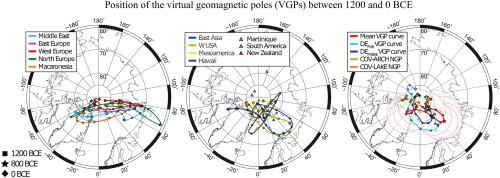Physics of the Earth and Planetary Interiors ( IF 2.4 ) Pub Date : 2021-04-17 , DOI: 10.1016/j.pepi.2021.106712 Gwenaël Hervé , Annick Chauvin , Philippe Lanos , Florian Lhuillier , Sylvie Boulud-Gazo , Mario Denti , Raphaël Macario

|
Despite progress in the knowledge of secular variation during the first millennium BCE in Europe, data coverage remains poor at the earliest periods, especially in some regions as in the Central Mediterranean area. This study presents three new directional and six new intensity data between the 13th and the 4th centuries BCE on archaeological kilns, pottery and baked clay fragments from South Italy and France. Archaeodirections were determined after thermal demagnetizations and archaeointensities using the Thellier-Thellier protocol with corrections for the anisotropy and cooling rate effects. The new data confirm the large deviation of the direction from a Geocentric Axial Dipole field, the high geomagnetic field strength and the fast secular variation observed in Europe during the earliest half of the first millennium BCE. Another characteristic of this period is a difference of ~25° between the longitudes of the virtual geomagnetic poles inferred from European and Middle East data. This unusual behaviour can be mainly related to the Levantine Iron Age anomaly (LIAA) and its expansion from the Middle East to Europe. However, the review of the global directional database shows that almost all virtual geomagnetic poles, 96% of them coming from Europe, the Middle East, East Asia, North America and Hawaii, are 10–25° away from the rotation axis towards North Russia between 1000 and 600 BCE. The calculation of a mean global VGP curve suggests that the North geomagnetic pole followed a clockwise motion during this period with a dipole tilt up to around 14°. This study shows that a dipole axis tilt may have played an important role in the rapid secular variation in western Eurasia, although part of this variation may also be related to non-dipole fields associated with the LIAA.
中文翻译:

公元前第一个千年,偶极子轴如何变化?西欧的新数据和定向全球数据库的分析
尽管在公元前一千年的欧洲,人们对世俗变异的认识有所进步,但最早的数据覆盖率仍然很低,尤其是在中地中海地区的某些地区。这项研究提出了在公元前13世纪至4世纪之间来自意大利南部和法国的考古窑,陶器和烤制粘土碎片的三个新的方向性数据和六个新的强度数据。使用Thellier-Thellier协议对各向异性进行了消磁和冷却后,确定了古方向,并修正了各向异性和冷却速率的影响。新数据证实,在公元前一千年的前半期,在欧洲观测到的地心轴向偶极子场的方向存在较大偏差,地磁场强度高,并且长期变化迅速。这个时期的另一个特征是从欧洲和中东的数据推算出的虚拟地磁极的经度之间相差约25°。这种异常行为可能主要与黎凡特铁器时代异常(LIAA)及其从中东扩展到欧洲有关。但是,对全球方向数据库的审查显示,几乎所有虚拟地磁极(其中96%来自欧洲,中东,东亚,北美和夏威夷)与旋转轴朝俄罗斯北部的距离均为10–25°公元前1000年至600年之间。平均整体VGP曲线的计算表明,在此期间,北地磁极遵循顺时针方向运动,偶极子的倾斜度高达14°。











































 京公网安备 11010802027423号
京公网安备 11010802027423号